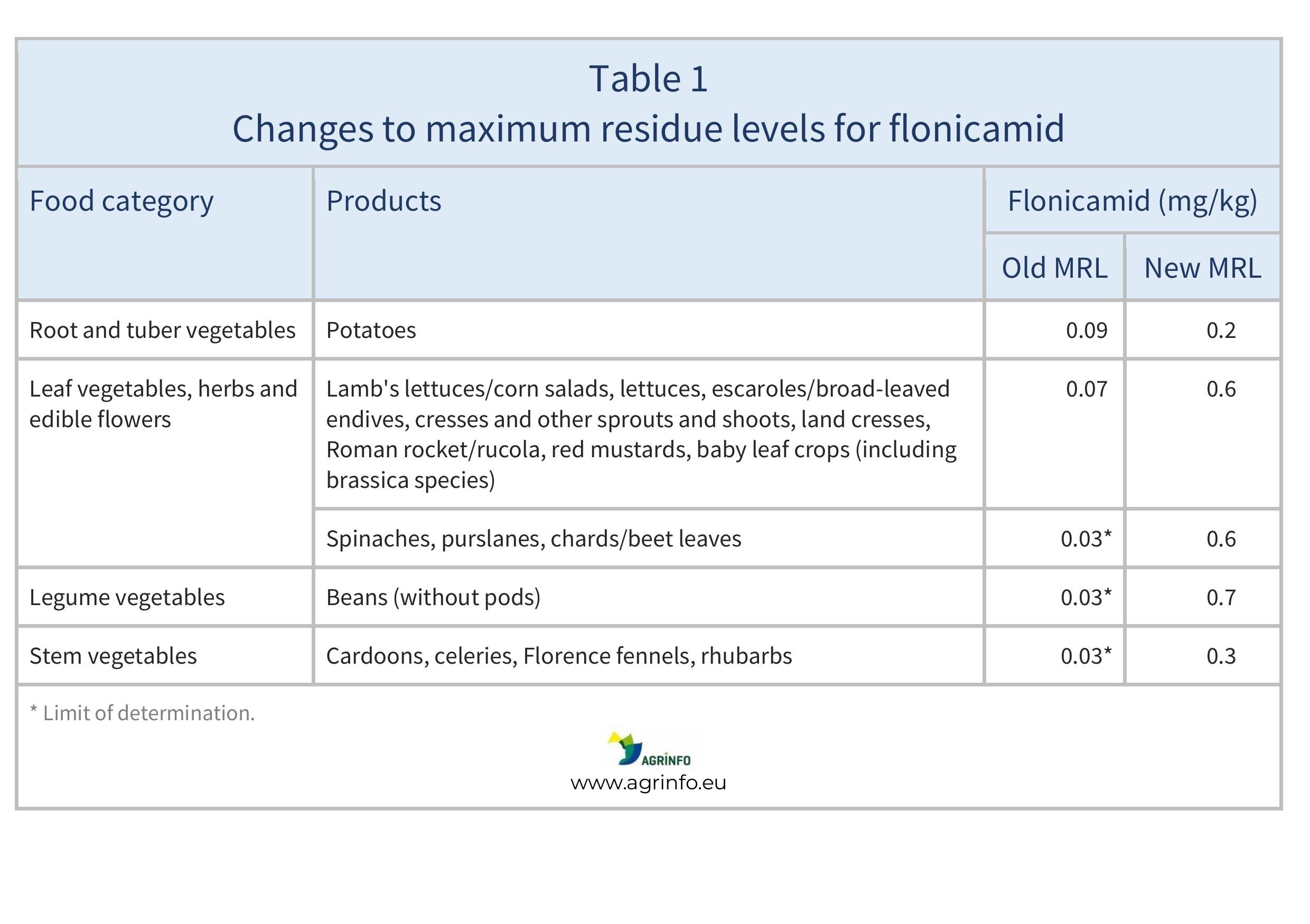Maximum residue levels for flonicamid
- Pesticide MRLs
Summary
The EU has raised the maximum residue levels (MRLs) for flonicamid on several products. This follows MRL increases for flonicamid on Chinese cabbages, kales, and kohlrabies.
EU raises MRLs for flonicamid on certain products
Commission Regulation (EU) 2024/2612 of 7 October 2024 amending Annexes II, III and IV to Regulation (EC) No 396/2005 of the European Parliament and of the Council as regards maximum residue levels for chitosan, clopyralid, difenoconazole, fat distillation residues, flonicamid, hydrolysed proteins, and lavandulyl senecioate in or on certain products
Commission Regulation (EU) 2024/1078 of 15 April 2024 amending Annexes II and IV to Regulation (EC) No 396/2005 of the European Parliament and of the Council as regards maximum residue levels for azoxystrobin, flonicamid, isofetamid, mefentrifluconazole, metazachlor, pyrimethanil and quartz sand in or on certain products
Update
The EU has raised the maximum residue levels (MRLs) for flonicamid on several products. This follows MRL increases for flonicamid on Chinese cabbages, kales, and kohlrabies.
Impacted Products
Potatoes, lamb's lettuces/corn salads, lettuces, escaroles/broad-leaved endives, cresses and other sprouts and shoots, land cresses, Roman rocket/rucola, red mustards, baby leaf crops (including brassica species), spinaches, purslanes, chards/beet leaves, beans (without pods), cardoons, celeries, Florence fennels, rhubarbs, Chinese cabbages, kales, kohlrabies
What is changing?
The EU has amended the MRLs for flonicamid as summarised in Table 1.
This follows increases to MRLs for flonicamid introduced on 6 May 2024 for leafy brassicas (Chinese cabbages and kales) from 0.03 to 0.5 mg/kg, and on kohlrabies from 0.03 to 0.15 mg/kg.
Why?
Following an application to modify the MRL, the EU agreed that data from residue trials on kales could be extrapolated to set MRLs on other leafy brassicas. No safety evaluation by the European Food Safety Authority (EFSA) was required.
Following a new application to modify flonicamid MRLs on potatoes, lettuces and salad plants, spinaches and similar leaves, beans (without pods), cardoons, celeries, Florence fennels, and rhubarbs, EFSA (2024) concluded that all data requirements were met and the modifications were acceptable for consumer safety.
Timeline
The new MRLs in Table 1 apply from 28 October 2024.
The MRLs on Chines cabbages, kales, and kohlrabies apply since 6 May 2024.
Background
MRLs are set in accordance with the rules set out in Regulation 396/2005. For information on current MRLs for other substances, please consult the EU Pesticide Residues database.
Resources
EFSA (2024) Modification of the existing maximum residue levels for flonicamid in various crops. EFSA Journal, 22: e8545.
Sources
Regulation (EU) 2024/2612 as regards maximum residue levels for chitosan, clopyralid, difenoconazole, fat distillation residues, flonicamid, hydrolysed proteins, and lavandulyl senecioate in or on certain products
Regulation 2024/1078 as regards maximum residue levels for azoxystrobin, flonicamid, isofetamid, mefentrifluconazole, metazachlor, pyrimethanil and quartz sand in or on certain products
Tables & Figures

Source: Regulation (EU) 2024/2612
Disclaimer: Under no circumstances shall COLEAD be liable for any loss, damage, liability or expense incurred or suffered that is claimed to have resulted from the use of information available on this website or any link to external sites. The use of the website is at the user’s sole risk and responsibility. This information platform was created and maintained with the financial support of the European Union. Its contents do not, however, reflect the views of the European Union.
EU raises MRLs for flonicamid on certain products
Regulation (EU) 2024/2612 as regards maximum residue levels for chitosan, clopyralid, difenoconazole, fat distillation residues, flonicamid, hydrolysed proteins, and lavandulyl senecioate in or on certain products
Regulation 2024/1078 as regards maximum residue levels for azoxystrobin, flonicamid, isofetamid, mefentrifluconazole, metazachlor, pyrimethanil and quartz sand in or on certain products
What is changing and why?
Following an application to modify the maximum residue levels (MRLs) for flonicamid, the EU has amended the MRLs for certain products as summarised in Table 1.
This follows increases to flonicamid MRLs introduced on 6 May 2024 for leafy brassicas (Chinese cabbages and kales) from 0.03 to 0.5 mg/kg, and on kohlrabies from 0.03 to 0.15 mg/kg.
Timeline
The new MRLs apply from 28 October 2024.
The MRLs on Chinese cabbages, kales, and kohlrabies apply since 6 May 2024.
Tables & Figures

Source: Regulation (EU) 2024/2612
Disclaimer: Under no circumstances shall COLEAD be liable for any loss, damage, liability or expense incurred or suffered that is claimed to have resulted from the use of information available on this website or any link to external sites. The use of the website is at the user’s sole risk and responsibility. This information platform was created and maintained with the financial support of the European Union. Its contents do not, however, reflect the views of the European Union.
